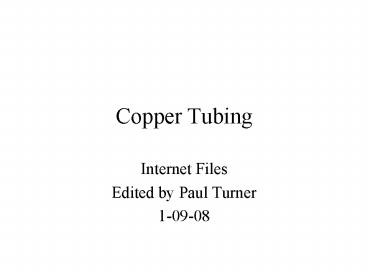Copper Tubing - PowerPoint PPT Presentation
1 / 25
Title:
Copper Tubing
Description:
Copper Tubing Internet Files Edited by Paul Turner 1-09-08 Cutting Tubing When cutting a pipe, it is good to use the pipe cutter as shown in Figure 1. – PowerPoint PPT presentation
Number of Views:782
Avg rating:3.0/5.0
Title: Copper Tubing
1
Copper Tubing
- Internet Files
- Edited by Paul Turner
- 1-09-08
2
Cutting TubingWhen cutting a pipe, it is good to
use the pipe cutter as shown in Figure 1. If a
hand saw is used for the cutting a pipe, it may
be crushed
This is a pipe cutter for cutting a comparatively
thin pipe. If it is a copper pipe to a diameter
12 mm grade, it can cut easily.
The pipe cutter is turned binding the edge of a
pipe cutter tight. With the repeated rotation,
the pipe can be cut finely.
3
For bending the copper pipe which became hard,
The copper pipe get harder as it ages and it
may be hard to bend. In such cases, it will
become soft if a copper pipe is lightly heated
with a gas burner.
4
Tubing Benders
5
A Copper pipe is put into the tool, and bent to
the required angle
6
(No Transcript)
7
There are many methods of connecting pipes.
The flaring connection is the most fundamental
and easy method.
http//www.nmri.go.jp/eng/khirata/metalwork/others
/pipe/index_e.html
8
Flare FittingsFlare fittings are used with soft
copper pipe. Similar to compression couplings,
they are used to join pipes to each other or join
pipes to fittings, but a flared coupling is
different from a compression joint because there
is no ferrule. A special fitting joint called a
union is used to join the flared ends of two
copper pipes together. The flared ends make a lip
in the pipe that is squeezed between the nut and
the body of the fitting. Flaring the end of a
pipe requires a special two piece tool called a
flaring tool. One piece holds the end of the pipe
in place. The other piece is essentially a rod,
called a compression cone, that is slightly wider
than the pipe. This cone is pushed into the open
end of the pipe, forcing it back and forming the
lip on the end of the pipe.
9
How to use a flared joint to attach a fixture
First slide the nut onto the pipe, then clamp
the end of the pipe into the flaring tool. Force
the compression cone into the end of the tubing
and slowly tighten it. As the cone forces its way
into the pipe, it should widen the pipe and fold
it backwards, making the lip. It's always as a
good idea to flare the pipe end before cutting
the pipe to length since pipes will sometimes
crack when they are being flared and you need to
start the process over. Put the flared end of the
pipe into the seat of the fixture and tighten the
nut.
http//www.doityourself.com/stry/cutjoincopperpipe
10
(No Transcript)
11
Bugle Shaped end
Co
mpleted Flare
12
Flare fittings
13
Joining copper to other piping materials By Tim
Carter http//www.askthebuilder.com/657_Copper_Tub
ing.shtml
You can connect the new copper piping to the
galvanized iron piping, but you need to use
special connectors that isolate the two metals.
If you allow the copper to contact the galvanized
iron piping directly, a galvanic reaction occurs,
and causes the iron piping to corrode. Eventually
a leak will develop at this spot of corrosion.
14
Sweating copper pipe! Clean is everything, even
new pipe and fittings need to be cleaned with
fine sandpaper or a wire brush. Remove all
burrs. Remember that water filled pipes can not
be soldered! Coat the surfaces to be joined with
a good quality rosin flux (prevents the copper
from oxidizing when heated.) Assemble the parts
and heat with a torch, when hot, touch the solder
to the joint and watch the solder (lead free)
flow completely into the joint.
PT 1-09-08
15
(No Transcript)
16
(No Transcript)
17
Apply flux to copper pipe and the interior of
fittings with a small brush.
18
Begin soldering by applying heat to the fitting
first, then in a waving motion, to the pipe. When
the pipe and fitting are at the right
temperature, the solder will flow into the joint
19
(No Transcript)
20
(No Transcript)
21
(No Transcript)
22
Hint!!!!!!!!!!! When sweating a pipe to a valve,
open the valve or better yet disassemble it to
prevent solder from getting into the valve body.
23
Compression Fittings
Compression fittings are a way of joining copper
pipes or a copper pipe to a fixture where you
can't solder or where you may have to take the
joint apart in the future. Toilet supply line is
a good example. A compression fitting consists of
three parts - compression nut, compression ring
(or ferrule - a metal or plastic washer that will
be "compressed" against the fitting) and the
compression seat. When attaching a compression
fitting, first get rid of any burrs from the
inside or outside of cut pipes. Then slide the
compression nut onto the end of the pipe (it'll
be a tight fit), then the ferrule.
24
The compression fitting itself will have a
threaded end. Slide the compression nut to the
end of the pipe and screw it onto the compression
fitting. Tightening the nut squeezes the
compression ring/ferrule into the seat and
against the copper pipe, making a watertight
seal. Hand tightening may be enough, but if you
get some drips you can tighten the joint using a
wrench. Applying some Teflon tape onto the
threads of the compression fitting will also help
prevent any small leaks.
http//www.doityourself.com/stry/cutjoincopperpipe
25
Good Bye!!































